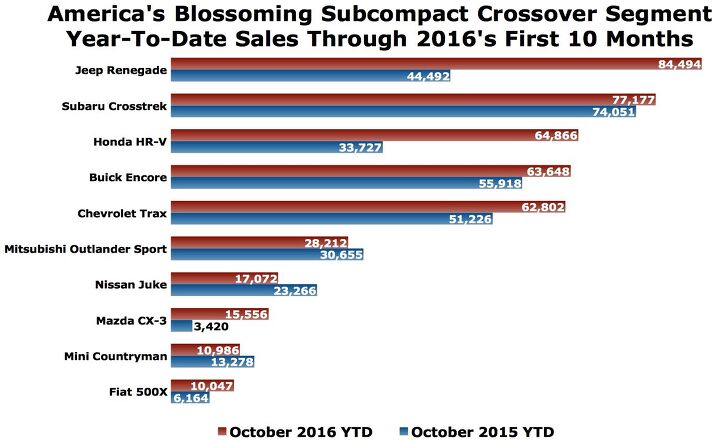Toyota Starts C-HR Production In Turkey - Surging Subcompact CUV Category Gets New Member
Bound for its North American production reveal at the Los Angeles Auto Show next week, production of the Toyota C-HR began today in Sakarya, Turkey.
The C-HR becomes the eighth vehicle built by Toyota in Europe and the third model built by Toyota Motor Manufacturing Turkey. The C-HR also joins a booming subcompact crossover segment that’s grown nearly 30 percent in the United States this year.
It’s a segment that now produces 3 percent of the U.S. auto industry’s volume, triple its share from just two years ago.
As new candidates join the fold, the overall segment grows its volume because existing nameplates tend — at least so far — to lose very little volume to the intruders.
Whether that will be true of the Toyota C-HR remains to be seen, of course. We don’t yet know its precise specifications, price point, or the breadth of Toyota’s marketing campaign.
But Toyota is a huge force in America’s SUV/crossover arena. The 4Runner, Highlander, Land Cruiser, Sequoia, and top-selling RAV4 grew their collective U.S. volume to 536,334 sales through the first ten months of 2016, a 12-percent increase for a quintet that now accounts for three-in-ten Toyota brand sales.
The RAV4 is America’s second-best-selling utility vehicle.
The Highlander is America’s second-best-selling three-row vehicle.
The 4Runner is America’s second-best-selling body-on-frame SUV.
At Toyota’s upmarket Lexus division, the RX is America’s best-selling premium utility vehicle, and by a wide margin.
There is therefore plenty of reason to believe that Toyota can succeed in yet another utility vehicle category.
The Toyota C-HR exits a 5,000-employee Turkish factory that will now build 280,000 vehicles per year, nearly double the factory’s output prior to the C-HR era thanks to a €350 million ($384 million) investment. Toyota says the C-HR goes down the same line as the Corolla and Verso, although the C-HR is the first Toyota built outside Japan on the new TNGA architecture that underpins the latest Prius.
In order for the Toyota C-HR to reproduce RAV4esque dominance, the new Toyota will need to surpass the steadily growing Subaru Crosstrek (an admittedly large, but still sub-Forester, “subcompact”), the top-selling Jeep Renegade, and GM twins from Buick and Chevrolet that jointly hold 29 percent of the category, tops among any manufacturer.
Incidentally, with the market’s 6-percent slide in October, the rate of growth achieved by America’s subcompact crossover slowed notably just as Toyota readied production of the C-HR. While segment-wide sales rose 33 percent through the first three-quarters of 2016, October volume rose just 2 percent, year-over-year.
Timothy Cain is the founder of GoodCarBadCar.net, which obsesses over the free and frequent publication of U.S. and Canadian auto sales figures. Follow on Twitter @goodcarbadcar and on Facebook.
More by Timothy Cain
Latest Car Reviews
Read moreLatest Product Reviews
Read moreRecent Comments
- Brendan Duddy soon we'll see lawyers advertising big payout$ after getting injured by a 'rogue' vehicle
- Zerofoo @VoGhost - The earth is in a 12,000 year long warming cycle. Before that most of North America was covered by a glacier 2 miles thick in some places. Where did that glacier go? Industrial CO2 emissions didn't cause the melt. Climate change frauds have done a masterful job correlating .04% of our atmosphere with a 12,000 year warming trend and then blaming human industrial activity for something that long predates those human activities. Human caused climate change is a lie.
- Probert They already have hybrids, but these won't ever be them as they are built on the modular E-GMP skateboard.
- Justin You guys still looking for that sportbak? I just saw one on the Facebook marketplace in Arizona
- 28-Cars-Later I cannot remember what happens now, but there are whiteblocks in this period which develop a "tick" like sound which indicates they are toast (maybe head gasket?). Ten or so years ago I looked at an '03 or '04 S60 (I forget why) and I brought my Volvo indy along to tell me if it was worth my time - it ticked and that's when I learned this. This XC90 is probably worth about $300 as it sits, not kidding, and it will cost you conservatively $2500 for an engine swap (all the ones I see on car-part.com have north of 130K miles starting at $1,100 and that's not including freight to a shop, shop labor, other internals to do such as timing belt while engine out etc).



































Comments
Join the conversation
Any word of a US release date for this?
CH-R should be at the LA autoshow next week. Along with Alfa SUV and old Jag production... Civic Si and Rogue One Star Wars edition...?